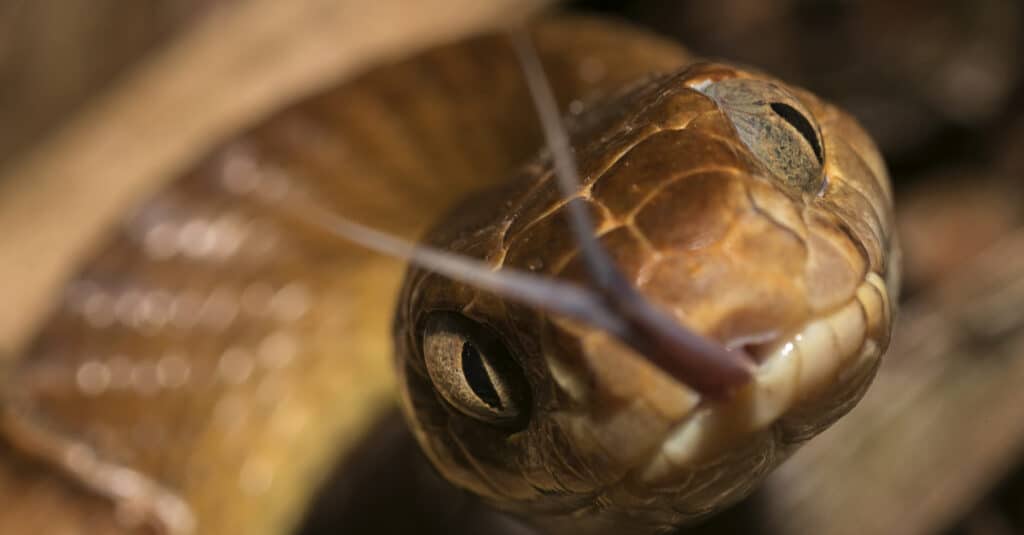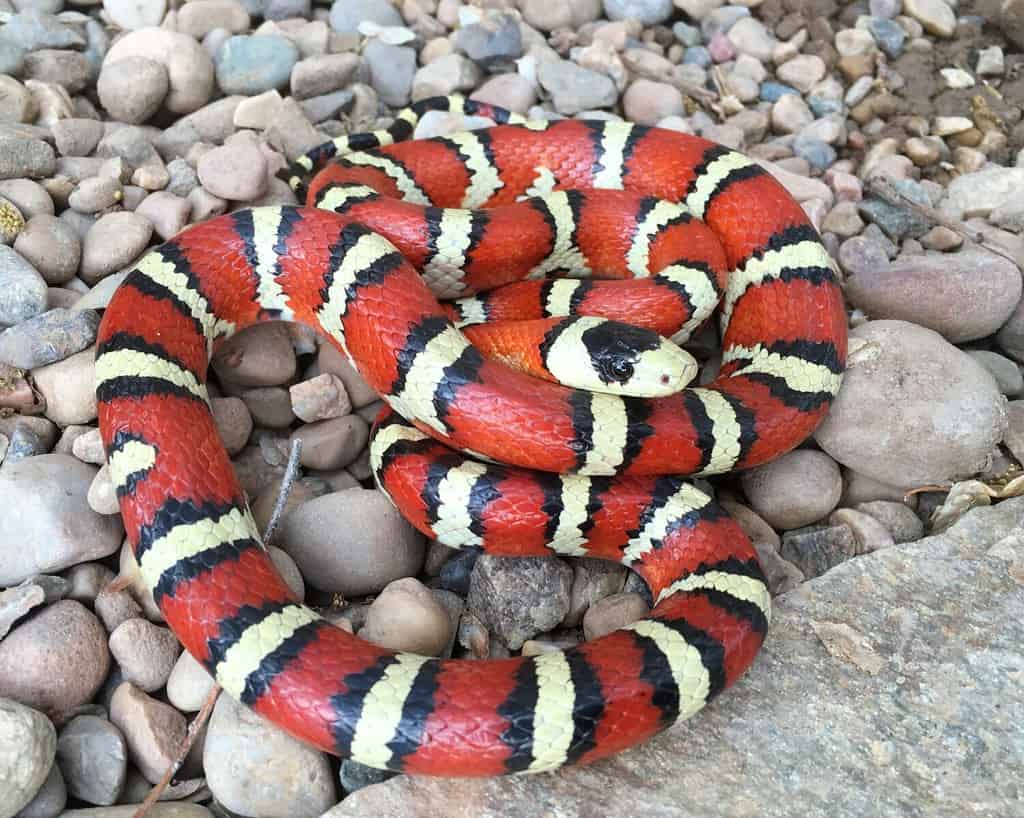While scientists have long understood why snakes flick their tongues, it looks like there’s more to the story. We know that snakes have what is called a “Jacobson’s Organ,” which is a sensory design feature associated with smell and, to a far lesser degree, taste.
When snakes flick their tongues, they are reading the room so to speak, gathering information about their environment through the Jacobson’s Organ (vomeronasal organ). Each, tiny particle that floats in the air is information to the snake. The snake gathers these particles each time it flicks its tongue, feeding the information to its brain.
Snakes aren’t the only creatures that feature a Jacobson’s organ but they are probably one of the most adept animals on earth at using theirs.
How Does a Snake’s Sense of Smell Work?

Headshot of a brown tree snake flicking its tongue.
©Firepac/Shutterstock.com
A snake’s sense of smell works via the tongue, Jacobson’s organ, and brain. While people use their tongues to taste food, snakes use theirs (paradoxically) as a tool for smell. With every flick of the tongue, a snake gathers more information regarding its surroundings.
The Jacobson’s organ is located directly above the roof of a snake’s mouth, with two vents that pass from the organ into the mouth as well. As the snake’s tongue retracts, it pulls in the particles it’s gathering, depositing them in its mouth where it then makes its way up into the vents.
The organ is more than just a holding place, however. Sensory cells line the organ and quickly parse through the incoming data, sending the information to the brain in short order. The more snakes flick their tongues, the clearer their understanding of their environment becomes.
Even the split at the end of a snake’s tongue serves a purpose. Since there are two vent slits in the roof of its mouth, each fork can deliver its own information. Oftentimes, the scent molecules floating around in the air are few in number. Because of this, snakes flick their tongues in a very specific way, optimizing the tongue’s ability to collect data by forcing the molecules to coalesce for mass gathering.
Why Snakes Need a Jacobson’s Organ

The Indian python.
©iStock.com/reptiles4all
Contrary to popular belief, snakes are not the half-blind reptiles they’re often made out to be. It makes sense to assume that Jacobson’s organ is necessary because of poor eyesight but snakes see better than we give them credit for. They can’t see as well as humans, for the most part, and they certainly lack eagle vision.
But they aren’t exactly blind either. Snakes are fairly sensitive to UV light. The types of snakes that hunt at night have a lens that allows excessive UV light in. Snakes that hunt in the daytime have a lens that blocks UV light.
Snakes have a dichromatic vision in the daytime, meaning they see two colors as opposed to a human’s ability to see three. As far as hearing goes, again, snakes are far more adept than we give them credit for. For one, snakes are highly tactile creatures, sensing vibrations rather than hearing them. For instance, a snake probably feels you walking closer before it hears you.
Snakes also have airborne hearing, meaning they sense auditory vibrations in the air. However, they are only capable of hearing sub-600Hz. Humans have a much broader sense of hearing and, to a snake, most of the frequencies we hear would sound muffled or filtered through several walls.
So, if snakes can hear okay and see pretty well (day or night), what’s the point of Jacobson’s organ? Snakes flick their tongues as their dominant means of information gathering, much in the same way that humans use their eyesight as the primary means of taking in the world around them.
Historical Perspective

Arizona kingsnakes have bright red, black, and white bands all the way down their bodies.
©Matt Jeppson/Shutterstock.com
It took us a long time to reach a general understanding of why snakes flick their tongues. As brilliant as ancient philosopher Aristotle was, he postulated that snakes have forked tongues and they flick them to essentially double their pleasure. If you twist the fabric of reality enough, Aristotle was correct in only the vaguest definition of the term.
Giovanni Battista Hodierna, a naturalist in the 1600s, thought snakes picked their noses with their forked tongues. Interesting, if not hilarious, to say the least. Back in those days, however, most people thought the flickering tongue was the snake equivalent of a poisonous dart.
It wasn’t until Jean-Baptiste Lamarck (a French naturalist) came along that science began to approach tongue-flicking as a means of information gathering. Lamarck surmised that snakes use their tongues as a sense of touch, compensating for their poor vision. He was close but not quite correct.
Lamarck’s assumption held as the popular belief among scientists until the 20th century gave way to new discoveries and a better understanding of the Jacobson’s organ.
How Snakes Respond and Navigate Their Environment

Snake handler with a python.
©Janelle Lugge/Shutterstock.com
Though snakes flick their tongues as a primary means of information gathering, they actually use all of their senses to navigate their environment and respond to the presence of potential prey or danger.
Snakes are very sensitive to vibrations in the earth. They have adequate, though non-exceptional, hearing and they are able to see relatively well. Combined with frequent tongue flicks, snakes are able to gather information and formulate a response in the blink of an eye.
Though the tongue itself cannot taste or smell, it is the facilitator for both, at least from the snake’s point of view or version of tasting and smelling. The fork allows the snake to collect double the information or even specific and distinct information for each fork.
Snake biologist, Neil Ford, ascertained the use of the tongue in terms of mating. The forked nature of a snake’s tongue plays an interesting role in that as well, similar to dowsing. According to Ford, so long as both forks remain within the pheromone trail of a likely mate, the snake continues in a direct path.
If only one fork touches the pheromone trail, the snake will adjust itself to continue following the path. Like dowsing for water (a mysterious and interesting method for finding water beneath the earth), this proves that a snake’s tongue is useful for positioning and direction.
When you combine all of a snake’s capabilities into a single unit that works together, seamlessly and with frightening accuracy, the snake becomes a veritable sensory powerhouse.
Final Thoughts on Why Snakes Flick Their Tongues
Snakes flick their tongues as their primary source of information gathering. From a human perspective, we might define this ‘information’ as smell or taste. It is probably the most potent information-gathering and interpretation method within the snake’s sensory arsenal.
Despite the average human being’s aversion to snakes, in all their sizes and stunning colorations, there’s no denying the incredible way they see and interact with the world. The Jacobson’s organ is a unique sensory device and it serves snakes very well and in many ways. Without it, they would not be able to survive in their environments and we would never see snakes flick their tongues in the way they do.
Discover the "Monster" Snake 5X Bigger than an Anaconda
Every day A-Z Animals sends out some of the most incredible facts in the world from our free newsletter. Want to discover the 10 most beautiful snakes in the world, a "snake island" where you're never more than 3 feet from danger, or a "monster" snake 5X larger than an anaconda? Then sign up right now and you'll start receiving our daily newsletter absolutely free.
Thank you for reading! Have some feedback for us? Contact the AZ Animals editorial team.








